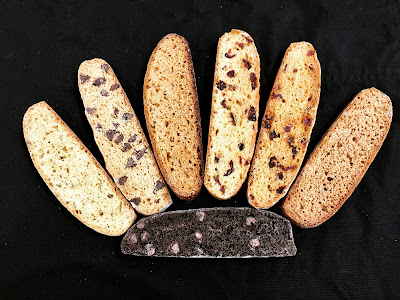The History of Biscotti
Amanda’s Biscotti
Amanda has been making Biscotti for over 15 years.
Her flavors include: Lavender Honey, Cranberry Orange, Chocolate with Chocolate Chip, Anise, Spice, Cranberry, Lemon Poppy, and Toasted Coconut with Chocolate Chips.
The biscotti, those delightful, twice-baked Italian cookies that have captured the hearts and taste buds of many around the world. To embark on a deep dive into the origins of biscotti is to journey through time and savor the rich history of this beloved treat.
Our story begins in the heart of ancient Italy, where biscotti, or "biscotti di Prato" as they were originally known, were born. The word "biscotti" itself stems from the Latin "bis" (twice) and "coctum" (baked), a fitting name for cookies that undergo a double baking process.
The Birthplace: Prato, Tuscany
Prato, a charming town in the Tuscany region of Italy, is credited with giving birth to biscotti. The origins can be traced back to the 14th century, where these treats were initially created by local bakers. Prato's dry, sunny climate made it an ideal location for baking goods that could withstand long journeys, and biscotti fit the bill perfectly.
The Purpose: Long-lasting Sustenance
In their early days, biscotti were prized for their longevity. The double-baking process removed most of the moisture, making them resistant to spoilage during extended periods of storage. This made them a favored choice for sailors and travelers, as biscotti could be taken on long journeys without fear of spoilage.
The Recipe: Simplicity and Versatility
Biscotti were initially made with just a handful of ingredients: flour, sugar, eggs, and almonds. These ingredients were readily available, and their simplicity made biscotti accessible to a wide audience.
As time went on, variations emerged. Almonds were sometimes replaced with other nuts or dried fruits, and flavorings like anise or citrus zest were added for extra flair. This adaptability allowed biscotti to evolve with changing tastes and preferences.
The Renaissance Influence: A Staple for the Elite
During the Renaissance period, biscotti took on a more refined role. Wealthy families in Italy enjoyed them as a delicacy, often dipping them in Vin Santo, a sweet dessert wine. The crunchy texture of biscotti made them an ideal companion for sipping wine or coffee.
Modern-Day Popularity: A Global Treat
Today, biscotti have transcended their humble beginnings in Prato and can be found in bakeries worldwide. Their enduring popularity lies in their versatility; they can be enjoyed on their own, dipped in coffee, tea, or wine, or even used as an ingredient in desserts like tiramisu.
In conclusion, the journey of biscotti is a tale of simplicity, versatility, and endurance. From their humble origins in the sun-soaked town of Prato to becoming a global treat enjoyed by people of all backgrounds, biscotti's story mirrors the very essence of Italian cuisine: simple, yet bursting with flavor and history. So, as you savor Amanda's biscotti with your next cup of coffee, know that you are indulging in a centuries-old tradition that has enchanted palates throughout the ages.
